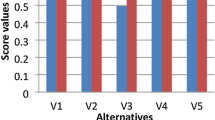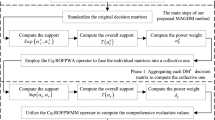Abstract
The q-rung orthopair fuzzy sets (q-ROFSs) can serve as a generalization of intuitionistic fuzzy sets (IFSs) and Pythagorean fuzzy sets (PFSs). q-ROFSs provide more freedom for decision makers in describing their opinions than other ordinary orthopair fuzzy sets. In this paper, a novel multiple attribute group decision making(MAGDM) method is constructed under q-rung orthopair fuzzy (q-ROF) environment. First, considering the projection measure provides the distance and the angle between two alternatives simultaneously, this work investigates a new normalized bidirectional projection model (NBPM) of q-ROFSs. By combining the proposed NBPM with Jaynes maximum entropy method, a nonlinear programming model is constructed to calculate the objective attribute weight information. Second, we present a new entropy measure based on the proposed generalized p-norm knowledge-based measure which takes into account both the membership and non-membership functions and the inherent fuzziness of q-ROFSs. Then the weights of decision makers are given by the proposed entropy measure. Furthermore, an integrated MAGDM framework is presented by using the weight determination methods of decision makers and attributes under q-ROF environment. Finally, an illustrative example is given to illustrate the operation process of the proposed decision-making method, sensitivity analysis and comparison analysis are also performed to show the effectiveness and superiority of the proposed method.



Similar content being viewed by others
Explore related subjects
Discover the latest articles, news and stories from top researchers in related subjects.References
Boran FE, Genç S, Kurt M, Akay D (2009) A multi-criteria intuitionistic fuzzy group decision making for supplier selection with topsis method. Expert Syst Appl 36(8):11363–11368
Liu Z, Liu P (2017) Intuitionistic uncertain linguistic partitioned bonferroni means and their application to multiple attribute decision-making. Int J Syst Sci 48(5):1092–1105
Yu C, Shao Y, Wang K, Zhang L (2019) A group decision making sustainable supplier selection approach using extended topsis under interval-valued pythagorean fuzzy environment. Expert Syst Appl 121:1–17
Shi H, Wang L, Li X-Y, Liu H-C (2020) A novel method for failure mode and effects analysis using fuzzy evidential reasoning and fuzzy petri nets. J Ambient Intell Humaniz Comput 11:2381–2395
Darko AP, Liang D (2020) Some q-rung orthopair fuzzy hamacher aggregation operators and their application to multiple attribute group decision making with modified edas method. Eng Appl Artif Intell 87:103259
Zadeh LA (1965) Fuzzy sets. Inf Control 8(3):338–353
Bustince H, Barrenechea E, Pagola M, Fernandez J, Xu Z, Bedregal B, Montero J, Hagras H, Herrera F, De Baets B (2015) A historical account of types of fuzzy sets and their relationships. IEEE Trans Fuzzy Syst 24(1):179–194
Atanassov KT (1999) Intuitionistic fuzzy sets. In: Intuitionistic fuzzy sets. Springer, New York, pp 1–137
Yager RR (2013) Pythagorean membership grades in multicriteria decision making. IEEE Trans Fuzzy Syst 22(4):958–965
Torra V (2010) Hesitant fuzzy sets. Int J Intell Syst 25(6):529–539
Yager RR (2016) Generalized orthopair fuzzy sets. IEEE Trans Fuzzy Syst 25(5):1222–1230
Liu P, Wang P (2018) Some q-rung orthopair fuzzy aggregation operators and their applications to multiple-attribute decision making. Int J Intell Syst 33(2):259–280
Wang P, Wei G, Wang J, Lin R, Wei Y (2019) Dual hesitant q-rung orthopair fuzzy hamacher aggregation operators and their applications in scheme selection of construction project. Symmetry 11(6):771
Shu X, Ai Z, Xu Z, Ye J (2019) Integrations of q-rung orthopair fuzzy continuous information. IEEE Trans Fuzzy Syst 27(10):1974–1985
Krishankumar R, Ravichandran K, Kar S, Cavallaro F, Zavadskas EK, Mardani A (2019) Scientific decision framework for evaluation of renewable energy sources under q-rung orthopair fuzzy set with partially known weight information. Sustainability 11(15):4202
Xu Z, Hu H (2010) Projection models for intuitionistic fuzzy multiple attribute decision making. Int J Inf Technol Decis Making 9(02):267–280
Liang D, Xu Z, Darko AP (2017) Projection model for fusing the information of pythagorean fuzzy multicriteria group decision making based on geometric bonferroni mean. Int J Intell Syst 32(9):966–987
Huang J, Xu D-H, Liu H-C, Song M-S. A new model for failure mode and effect analysis integrating linguistic z-numbers and projection method. IEEE Trans Fuzzy Syst. https://doi.org/10.1109/tfuzz.2019.2955916
Peng D, Wang J, Liu D, Liu Z (2019) The similarity measures for linguistic q-rung orthopair fuzzy multi-criteria group decision making using projection method. IEEE Access 7:176732–176745
Yue C (2017) Two normalized projection models and application to group decision-making. J Intell Fuzzy Syst 32(6):4389–4402
Liu P, You X (2019) Bidirectional projection measure of linguistic neutrosophic numbers and their application to multi-criteria group decision making. Comput Ind Eng 128:447–457
Ji P, Zhang H-Y, Wang J-Q (2018) A projection-based outranking method with multi-hesitant fuzzy linguistic term sets for hotel location selection. Cogn Comput 10(5):737–751
Wang L, Zhang H-Y, Wang J-Q, Li L (2018) Picture fuzzy normalized projection-based Vikor method for the risk evaluation of construction project. Appl Soft Comput 64:216–226
Sun R, Hu J, Zhou J, Chen X (2018) A hesitant fuzzy linguistic projection-based mabac method for patients prioritization. Int J Fuzzy Syst 20(7):2144–2160
Yue C (2019) A normalized projection-based group decision-making method with heterogeneous decision information and application to software development effort assessment. Appl Intell 49(10):3587–3605
Koksalmis E, Kabak Ö (2019) Deriving decision makers weights in group decision making: An overview of objective methods. Inf Fusion 49:146–160
Shannon CE (1948) A mathematical theory of communication. Bell Syst Tech J 27(3):379–423
De Luca A, Termini S (1972) A definition of a nonprobabilistic entropy in the setting of fuzzy sets theory. Inf Control 20(4):301–312
Szmidt E, Kacprzyk J (2001) Entropy for intuitionistic fuzzy sets. Fuzzy Sets Syst 118(3):467–477
Szmidt E, Kacprzyk J, Bujnowski P (2014) How to measure the amount of knowledge conveyed by Atanassovs intuitionistic fuzzy sets. Inf Sci 257:276–285
Guo K (2015) Knowledge measure for Atanassov’s intuitionistic fuzzy sets. IEEE Trans Fuzzy Syst 24(5):1072–1078
Peng X, Liu L (2019) Information measures for q-rung orthopair fuzzy sets. Int J Intell Syst 34(8):1795–1834
Nguyen H (2015) A new knowledge-based measure for intuitionistic fuzzy sets and its application in multiple attribute group decision making. Expert Syst Appl 42(22):8766–8774
Nguyen H (2020) A generalized p-norm knowledge-based score function for interval-valued intuitionistic fuzzy set in decision making. IEEE Trans Fuzzy Syst 28(3):409–423
Liu Z, Liu P, Liang X (2018) Multiple attribute decision-making method for dealing with heterogeneous relationship among attributes and unknown attribute weight information under q-rung orthopair fuzzy environment. Int J Intell Syst 33(9):1900–1928
Yager RR (2017) Generalized orthopair fuzzy sets. IEEE Trans Fuzzy Syst 25(5):1222–1230
Ji P, Zhang H-Y, Wang J-Q (2018) A projection-based Todim method under multi-valued neutrosophic environments and its application in personnel selection. Neural Comput Appl 29(1):221–234
Huang G, Liu Y (2005) The fuzzy entropy of vague sets based on non-fuzzy sets. Comput Appl Softw 22(6):16–17
Szmidt E, Kacprzyk J (2005) New measures of entropy for intuitionistic fuzzy sets. In: Ninth Int Conf IFSs Sofia, vol 11, pp 12–20
Li J, Deng G, Li H, Zeng W (2012) The relationship between similarity measure and entropy of intuitionistic fuzzy sets. Inf Sci 188:314–321
Szmidt E, Kacprzyk J (2005) A new measure of entropy and its connection with a similarity measure for intuitionistic fuzzy sets. In: EUSFLAT Conf., pp 461–466
Vlachos IK, Sergiadis GD (2007) Intuitionistic fuzzy information-applications to pattern recognition. Pattern Recogn Lett 28(2):197–206
Zhang Q-S, Jiang S-Y (2008) A note on information entropy measures for vague sets and its applications. Inf Sci 178(21):4184–4191
Liang X, Wei C, Xia M (2013) New entropy, similarity measure of intuitionistic fuzzy sets and their applications in group decision making. Int J Comput Intell Syst 6(5):987–1001
Liang D, Zhang Y, Cao W (2019) q-rung orthopair fuzzy Choquet integral aggregation and its application in heterogeneous multicriteria two-sided matching decision making. Int J Intell Syst 34(12):3275–3301
Liu Z, Wang S, Liu P (2018) Multiple attribute group decision making based on q-rung orthopair fuzzy heronian mean operators. Int J Intell Syst 33(12):2341–2363
Wang P, Wang J, Wei G, Wei C (2019) Similarity measures of q-rung orthopair fuzzy sets based on cosine function and their applications. Mathematics 7(4):340
Zhang X, Xu Z (2014) Extension of topsis to multiple criteria decision making with pythagorean fuzzy sets. Int J Intell Syst 29(12):1061–1078
Acknowledgements
This study was funded by the Social Sciences Research Project of Ministry of Education of China (No. 17YJA630065), the Shandong Provincial Natural Science Foundation (No. ZR2017MG007), the Humanities, the Science and Technology Project of Colleges and Universities of Shandong Province (NO. J16LN25), the Special Funds of Taishan Scholars Project of Shandong Province (No. Ts201511045).
Author information
Authors and Affiliations
Corresponding author
Ethics declarations
Conflict of interest
The authors declare that there is no conflict of interest regarding the publication of this paper.
Additional information
Publisher's Note
Springer Nature remains neutral with regard to jurisdictional claims in published maps and institutional affiliations.
Rights and permissions
About this article
Cite this article
Liu, Z., Wang, X., Li, L. et al. Q-rung orthopair fuzzy multiple attribute group decision-making method based on normalized bidirectional projection model and generalized knowledge-based entropy measure. J Ambient Intell Human Comput 12, 2715–2730 (2021). https://doi.org/10.1007/s12652-020-02433-w
Received:
Accepted:
Published:
Issue Date:
DOI: https://doi.org/10.1007/s12652-020-02433-w




